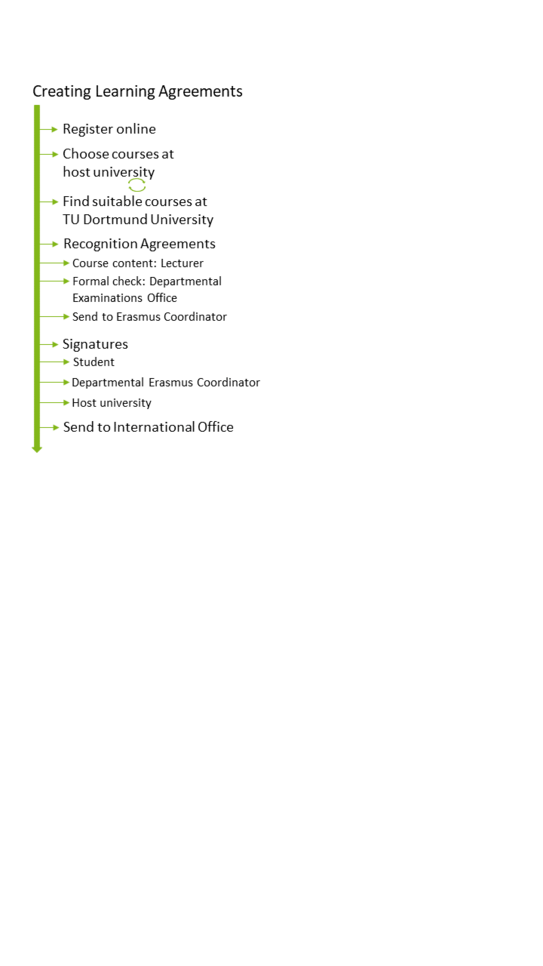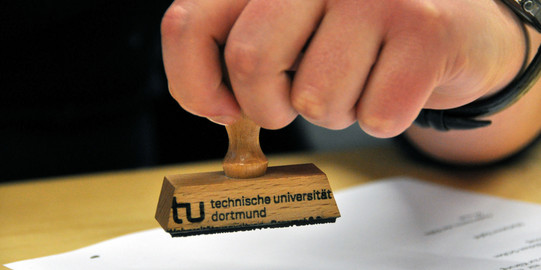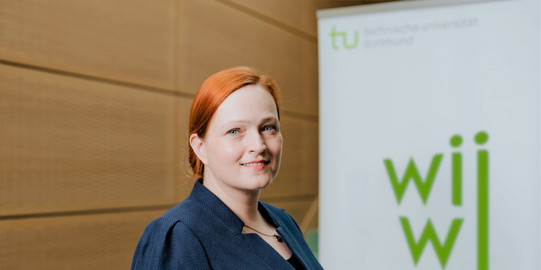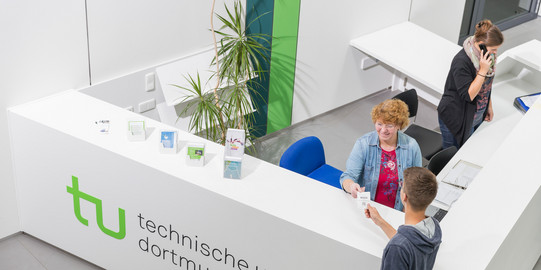Learning Agreements and Recognition Agreements
The Learning Agreement is an agreement between students, TU Dortmund University and the host university. It is an essential part of the Erasmus program. It specifies which courses you will attend at the host university and which courses will be recognized at TU Dortmund University.
In order for your achievements abroad to be recognized, you need a recognition agreement. Since the courses you wish to be recognized should be included in your Learning Agreement, you should already take care of the recognition agreements before your mobility. This involves checking whether the courses at the host university and the courses at TU Dortmund University that you would like to have recognized are comparable in terms of content and form.
The Learning Agreement enables a transparent and efficient preparation of your exchange. In addition, it is a needed to receive the mobility grant.

The Learning Agreement should be created online if possible. However, this is not yet possible at all partner universities. In this case, students can use a paper format (PDF format) instead.
Students can register for the online Learning Agreement at https://www.learning-agreement.eu/.
For the Learning Agreement, students can search for courses they would like to take in the course overviews of the partner university. In order to have these courses recognized, comparable courses must be found in the module handbooks of the student's own degree program.
If students have found suitable courses, recognition agreements should be entered into. The comparability of the courses' content is assessed by the contact persons at the professorships. The formal comparability will be assessed by the Departmental Examinations Office. Detailed information can be found here.
The recognition agreements should then be sent to the Departmental Erasmus Coordinator.
Courses at the host university should then be entered in table A of the university, the courses at TU Dortmund University, which are to be recognized later, in table B. More information can be found here.
The Learning Agreement is then signed first by the student and then by the Erasmus coordinator at the home university. It should then be signed by the host university.
Once the Learning Agreement has been signed by all three parties, it should be forwarded to the International Office.
FAQ on Learning Agreements and Recognition Agreements
You should plan courses for about 30 ECTS points at the host university. It is also important that you achieve at least 15 ECTS (i.e. pass courses for 15 ECTS points), otherwise you may have to pay back the mobility grant you received.
The formal check follows this scheme (in German). The courses should be comparable. This is assumed as a general rule if the course taken at the host university has at least 80% of the ECTS of the course you want to have recognized. Since most of our courses are 7.5 ECTS, this is usually 6 ECTS credits. If the courses have less than 6 ECTS points, then there will be a case-by-case review. The form of examination should also be comparable. In case of differences in the form of examination, this will be reviewed on a case-by-case basis.
In this case, it is best to write a short email directly to the Departmental Examinations Office before contacting the professors..
Bachelor's courses can be recognized as Bachelor's courses, Master's courses for Master's or Bachelor's courses (in cases where you can take a Master's course as a Bachelor's student).
During the formal check by the Departmental Examinations Office, it is also checked once again whether the match in content is plausible.
This applies to cases where the courses cover less than 80% of the ECTS of the courses for which they are to be credited AND an individual case-by-case review has resulted in the course not being able to be recognized.
In such a case, you should try to find two courses that match a course here. There are different ways to do this. For example, if you are just under the 6 ECTS limit, it is possible that you focus on one of the two courses you are using to have the course in question recognized. The content match of the second course can then be given a little more leeway. This can then be taken into account for later crediting.
Example: You want to have an entrepreneurship course recognized that has 5 ECTS and fits well with a course from the entrepreneurship module. You look for a second course that is thematically similar, even if it doesn't quite fit (Innovation Management, for example). Then the 5 ECTS course on Entrepreneurship can be weighted with 2/3, the other with 1/3. It is important that you decide this beforehand, not after receiving the grades.
Must the recognition agreement be signed by the Departmental Examination Office before the mobility?
No, the formal check of the courses in question can take place after the mobility. However, it is certainly better for everyone involved to know about any problems beforehand.
Furthermore, you can only enter courses in Table B of your Learning Agreement for which you have a signature from the relevant Teaching and Research Area and from the Departmental Examination Office.
In many cases, the Learning Agreement must be ready only a few weeks before the stay, or no deadline is set (however, it must be ready before the mobility, i.e. signed by all three parties). In some cases, however, the Learning Agreement must be handed in with the application. If this is the case for you and you cannot take care of the recognition in time, you can leave table B blank for the time being (or enter "0" in the online Learning Agreement).
The Learning Agreement can still be changed later by adding the corresponding courses in table B2 "Under the mobility".
In these cases, please contact the Departmental Erasmus Coordinator.
Yes. This does not always have to be done immediately; it can make sense, especially at the beginning of the lecture period at the host university, to wait a bit and thus, if possible, only have to change the Learning Agreement and request the signatures of all parties once.
European Student Identifier (ESI) - A digital identifier that allows students to uniquely identify themselves when accessing student mobility services online. The TU does not currently use this, so students can leave this field blank when filling it in.
Certain course areas are defined in the inter-institutional agreements between the universities that facilitate the exchange. An ISCED code (International Standard Classification of Education) is used for this purpose.
In our partnerships, we usually use 0311 - Economics or 0410 - Business and administration, not further defined, but others are also possible.
You can find the correct codes for your partner university in the overview of partnerships on the pages of the International Office. There you can search for your host university and then find the ISCED code under "more details".
If you have any further questions, please do not hesitate to contact the Departmental Erasmus Coordinator, Dr. Debra Hanning, the Departmental Examinations Office, or the International Office.













